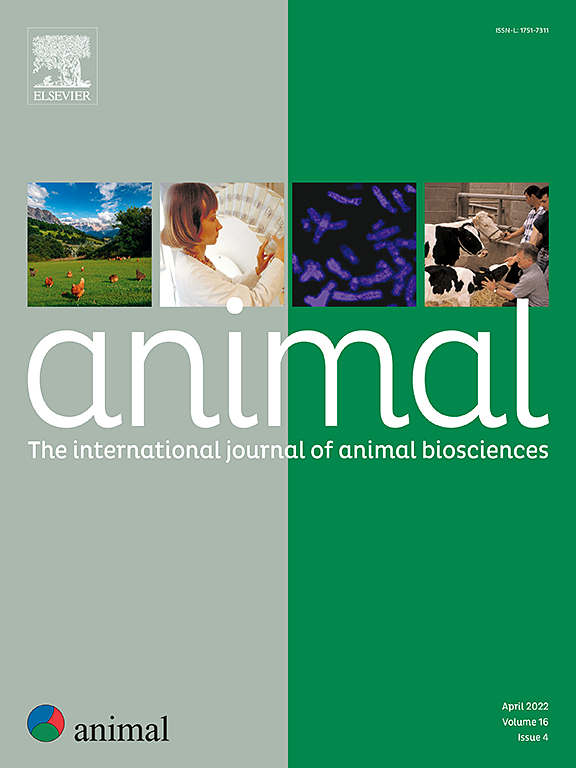Partial replacement of high-fibre forages with corn silage across the lactation cycle: effects on methane emission, rumen fermentation and efficiency in dairy cows
IF 4
2区 农林科学
Q1 AGRICULTURE, DAIRY & ANIMAL SCIENCE
引用次数: 0
Abstract
Feeding high-fibre forages to ruminants facilitates enteric methane emission but may also compromise milk yield. The aim of the present study was to investigate the possibility of reducing methane emission and improving feed conversion efficiency with a forage-based ration by replacing high-fibre forages with corn silage across the whole lactation cycle. Twenty-eight Holstein dairy cows were fed the same close-up diet for 21 days before their second parturition. After calving, cows with a divergent breeding value for functional herd life were equally allocated to a lactation diet containing forage (66% of DM) of either low (LCS; 31.1% DM) or high corn silage (HCS; 37.7% DM) proportion. The increase in the proportion of corn silage was achieved by partial replacement of grass silage, straw, and hay with corn silage. Diets were fed during the whole lactation period for ad libitum intake, and DM intake and milk production were recorded daily. Cows were weighed and evaluated for their body condition score, milk samples were analysed for fat, protein, and lactose, and blood samples were taken for the analysis of glucose, non-esterified fatty acid, beta-hydroxybutyrate, insulin, adiponectin, and IGF-1. In the respiration chambers, methane production, energy balance, and digesta mean retention time were measured and rumen fluid samples were taken for short-chain fatty acid analysis. Cows fed the HCS diet had greater DM intake, milk and energy-corrected milk yield during the whole lactation period than counterparts fed the LCS diet. The molar percent of acetate was lower and that of propionate and butyrate was higher in the rumen fluid of HCS compared to LCS cows. Methane production was not different between groups but methane yield and intensity were lower in the HCS than in the LCS group. Plasma glucose and IGF-1 concentrations were higher and adiponectin, beta-hydroxy butyrate and non-esterified fatty acid concentrations were lower in HCS compared to LCS cows. In contrast, plasma insulin concentrations were not different between groups. In conclusion, partial replacement of high-fibre forages with corn silage in a lactation diet for dairy cows increased metabolisable energy supply via an increase in DM intake and ruminal fermentation efficiency all of which led to an increase in milk production, a better metabolic status, improved feed and energy use efficiency, and reduced methane yield and intensity.
在整个泌乳周期用玉米青贮部分替代高纤维饲草:对奶牛甲烷排放、瘤胃发酵和效率的影响
用高纤维饲料喂养反刍动物会促进肠道甲烷排放,但也可能影响产奶量。本研究旨在探讨在泌乳期以玉米青贮代替高纤维饲料,减少甲烷排放和提高饲料转化效率的可能性。选取28头荷斯坦奶牛,在其第二次分娩前的21天内饲喂相同的近距离饲粮。产犊后,对群畜功能寿命具有不同繁殖价值的奶牛平均分配到含有低(LCS;31.1% DM)或高玉米青贮(HCS;37.7% DM)比例。玉米青贮比例的提高是通过玉米青贮部分替代草青贮、秸秆和干草来实现的。泌乳期全饲粮自由采食,每日记录干物质采食量和产奶量。对奶牛进行称重并评估其身体状况评分,对牛奶样本进行脂肪、蛋白质和乳糖分析,并对血液样本进行葡萄糖、非酯化脂肪酸、β -羟基丁酸、胰岛素、脂联素和IGF-1分析。在呼吸室中测量甲烷产量、能量平衡和食糜平均滞留时间,并采集瘤胃液样本进行短链脂肪酸分析。在整个哺乳期,饲喂HCS的奶牛的干物质摄入量、产奶量和能量修正产奶量均高于饲喂LCS的奶牛。与LCS奶牛相比,HCS奶牛瘤胃液中乙酸的摩尔百分比较低,丙酸和丁酸的摩尔百分比较高。各组间甲烷产量无显著差异,但甲烷产量和强度在HCS组低于LCS组。与LCS相比,HCS的血浆葡萄糖和IGF-1浓度较高,脂联素、β -羟基丁酸和非酯化脂肪酸浓度较低。相比之下,血浆胰岛素浓度在两组之间没有差异。综上所述,在泌乳期饲粮中,玉米青贮部分替代高纤维饲料增加了奶牛的代谢能供应,通过提高DM采食量和瘤胃发酵效率,提高了奶牛的产奶量,改善了奶牛的代谢状态,提高了饲料和能量利用效率,降低了甲烷产量和强度。
本文章由计算机程序翻译,如有差异,请以英文原文为准。
求助全文
约1分钟内获得全文
求助全文
来源期刊

Animal
农林科学-奶制品与动物科学
CiteScore
7.50
自引率
2.80%
发文量
246
审稿时长
3 months
期刊介绍:
Editorial board
animal attracts the best research in animal biology and animal systems from across the spectrum of the agricultural, biomedical, and environmental sciences. It is the central element in an exciting collaboration between the British Society of Animal Science (BSAS), Institut National de la Recherche Agronomique (INRA) and the European Federation of Animal Science (EAAP) and represents a merging of three scientific journals: Animal Science; Animal Research; Reproduction, Nutrition, Development. animal publishes original cutting-edge research, ''hot'' topics and horizon-scanning reviews on animal-related aspects of the life sciences at the molecular, cellular, organ, whole animal and production system levels. The main subject areas include: breeding and genetics; nutrition; physiology and functional biology of systems; behaviour, health and welfare; farming systems, environmental impact and climate change; product quality, human health and well-being. Animal models and papers dealing with the integration of research between these topics and their impact on the environment and people are particularly welcome.
 求助内容:
求助内容: 应助结果提醒方式:
应助结果提醒方式:


